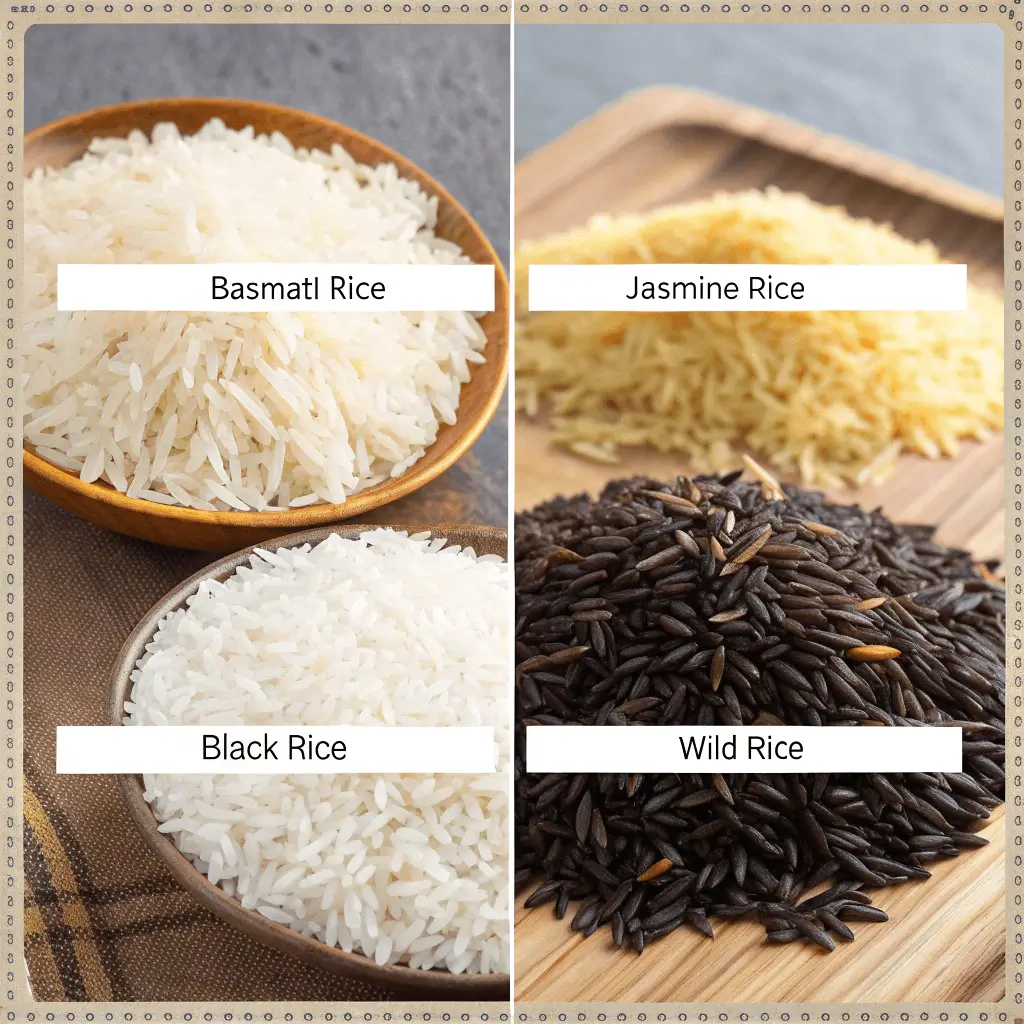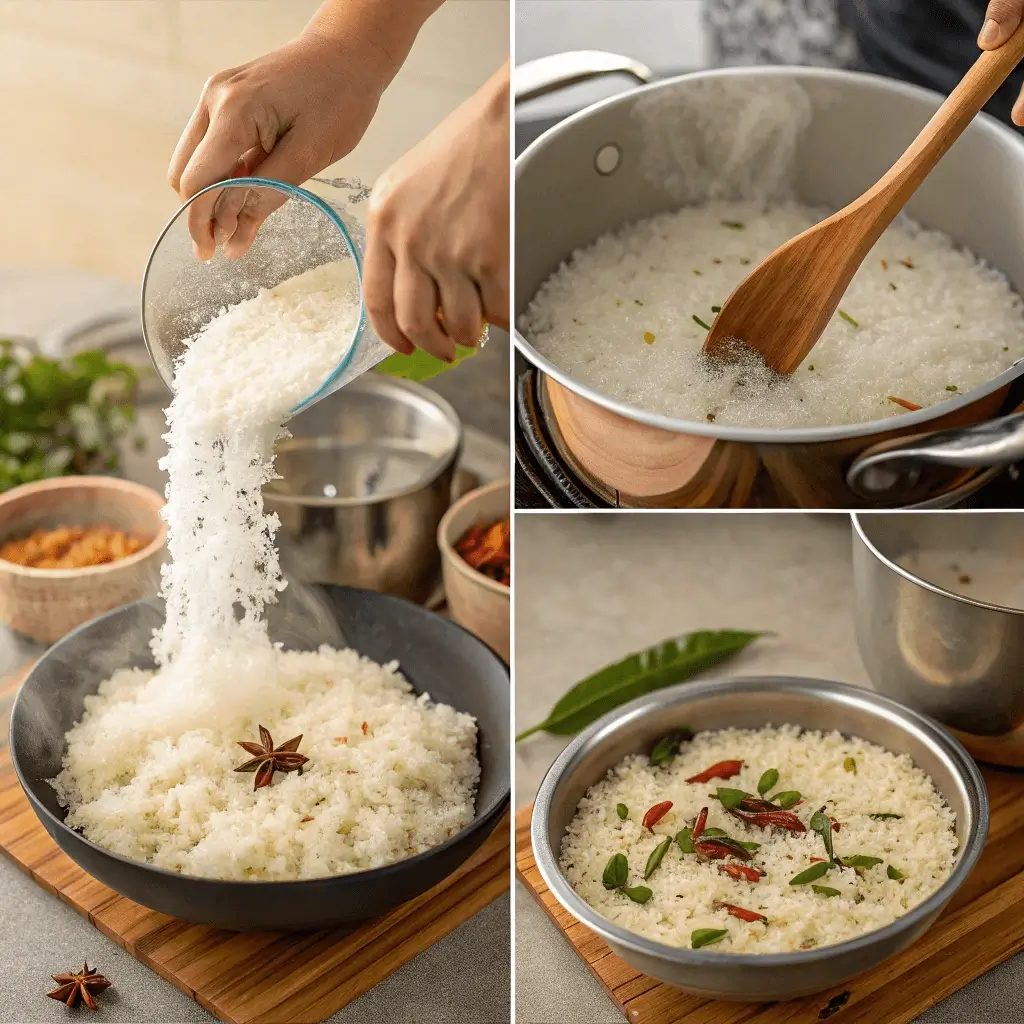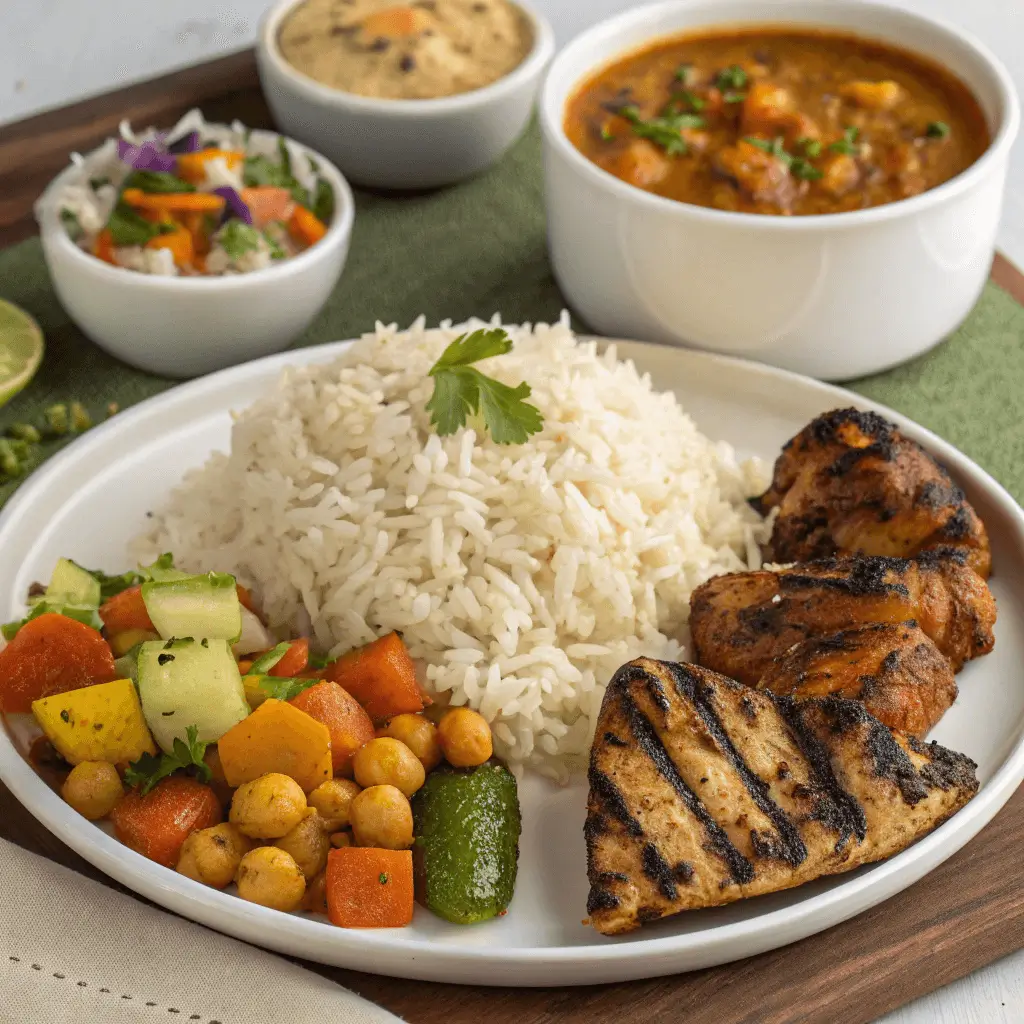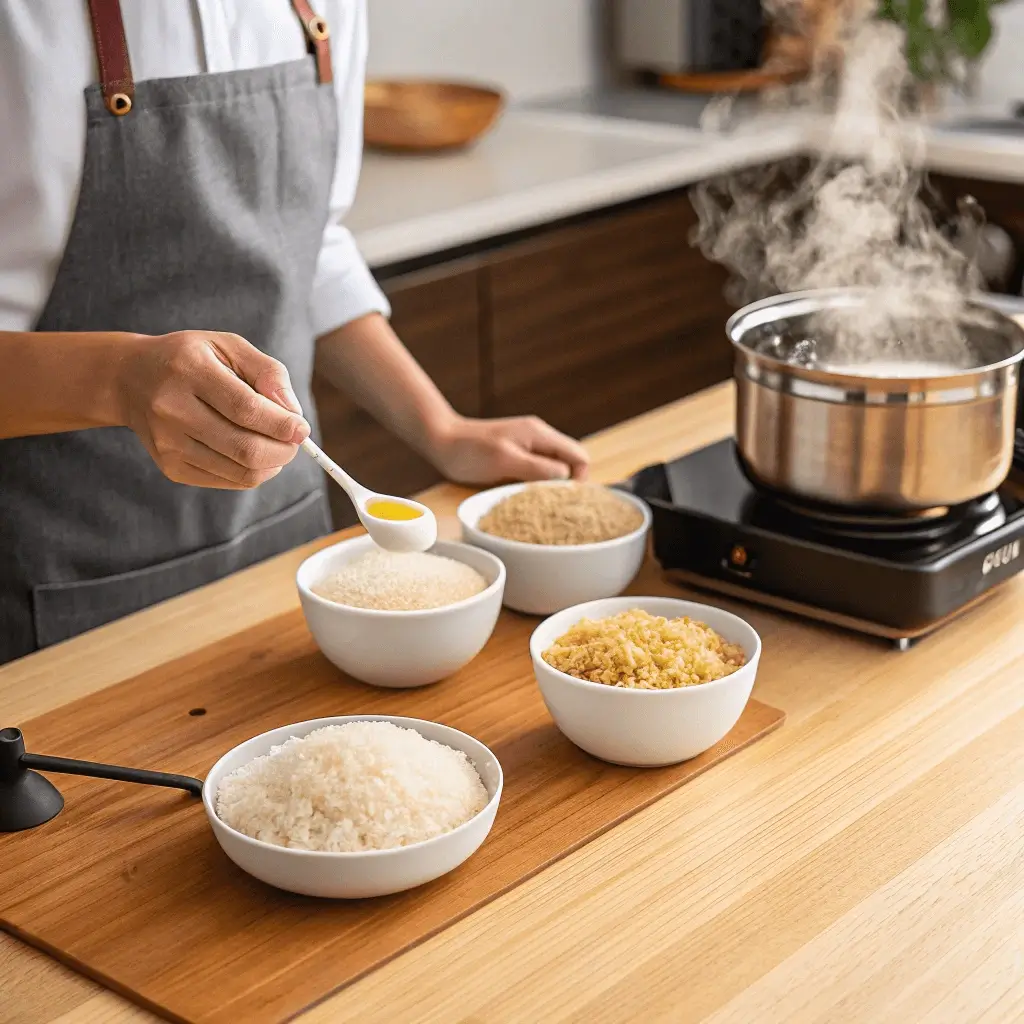“Why Try an Exotic Rice Hack Recipe?”
Rice is a staple enjoyed worldwide, and for those looking to elevate their meals with unique flavors, an Exotic Rice Hack is the perfect solution. Varieties like basmati, jasmine, black rice, and wild rice offer rich aromas, textures, and flavors that can transform any dish.
The Challenge of Cooking Exotic Rice.
While these exotic rice varieties are delicious, they often come with their own cooking challenges. From specific water ratios to precise cooking times, achieving the perfect texture can be tricky. But don’t worry—if you’re still getting the hang of rice cooking, starting with a Simple Rice Hack can help you master the basics before tackling these more complex varieties.
How This Simple Hack Helps
This easy method for cooking rice ensures that you can tackle even the trickiest rice varieties with confidence. Once you’ve mastered the basics, you can apply this technique to any exotic rice, ensuring consistent, perfect results every time.
A Healthy Bonus: Exotic Rice Hack for Weight Loss
In addition to improving your cooking skills, we’ll also explore a weight loss-friendly exotic rice hack, so you can enjoy flavorful rice while maintaining a healthy, balanced diet. By choosing the right rice and cooking methods, you’ll keep your meals nutritious and satisfying.
Understanding Exotic Rice Varieties

Exotic rice varieties have gained popularity worldwide for their distinct flavors, textures, and health benefits. Unlike regular white rice, these varieties offer a richer culinary experience and provide superior nutritional value. Understanding the unique characteristics of exotic rice will help you make better choices when selecting and cooking different types.
What is Exotic Rice?
Exotic rice includes a variety of aromatic, colorful, and nutrient-rich grains that go beyond standard white or brown rice. From fragrant basmati to nutty wild rice, each type has unique textures and flavors that enhance different dishes. However, cooking exotic rice can be tricky due to varying water-to-rice ratios and cooking times. If you’re new to cooking rice or want a foolproof method for perfect grains every time, mastering a Simple Rice Hack first can give you the confidence to experiment with more advanced rice varieties.
How Exotic Rice Differs from Regular Rice:
- Diverse Aromas: Varieties like basmati and jasmine rice have a fragrant, floral scent, while black and wild rice have a nutty, earthy aroma.
- Unique Textures: Some exotic rice varieties are light and fluffy (e.g., basmati), while others are chewy and dense (e.g., black and wild rice).
- Vibrant Colors: Exotic rice can range from golden hues (basmati) to deep purple or black (black rice), making them visually appealing and rich in antioxidants.
- Higher Nutritional Value: Unlike processed white rice, exotic rice varieties often retain more fiber, protein, and essential nutrients, making them a healthier option.
Popular Exotic Rice Varieties
With so many options available, let’s explore some of the most popular and widely used exotic rice varieties, each offering a distinct taste and texture.
1. Basmati Rice
- Origin: India and Pakistan
- Flavor & Texture: Long, slender grains with a light, fluffy texture and a signature floral aroma.
- Best Uses: Ideal for biryanis, pilafs, and Middle Eastern or South Asian dishes.
- Cooking Tip: Requires pre-soaking for 30 minutes to enhance its texture and reduce cooking time.
2. Jasmine Rice
- Origin: Thailand and Southeast Asia
- Flavor & Texture: Soft, slightly sticky grains with a delicate, buttery aroma.
- Best Uses: Common in Thai, Vietnamese, and Chinese cuisine, perfect for stir-fries and coconut rice dishes.
- Cooking Tip: Rinse before cooking to remove excess starch and achieve the perfect balance between fluffiness and stickiness.
3. Black Rice (Forbidden Rice)
- Origin: Ancient China (once reserved for royalty)
- Flavor & Texture: Chewy, nutty, and slightly sweet with a deep purple-black color when cooked.
- Best Uses: Great for grain bowls, salads, desserts, and sushi.
- Cooking Tip: Soaking overnight softens the grains and reduces cooking time. Rich in antioxidants like anthocyanins.
4. Wild Rice
- Origin: North America (technically a grass, not a true rice)
- Flavor & Texture: Firm, chewy texture with a robust, earthy, and nutty taste.
- Best Uses: Works well in soups, casseroles, grain salads, and stuffing.
- Cooking Tip: Requires a longer cooking time—typically 45–50 minutes—unless pre-soaked.
Each of these rice types provides a unique eating experience, making them ideal for a variety of recipes. Whether you prefer light and fragrant basmati, sticky and aromatic jasmine, or hearty and nutrient-dense black and wild rice, there is an exotic rice variety to match your preference.
Nutritional Benefits of Exotic Rice
Beyond their rich flavors and textures, exotic rice varieties are packed with essential nutrients that contribute to a balanced and healthy diet.
1. High in Fiber
- Brown, black, and wild rice contain significantly more fiber than white rice.
- Fiber supports digestion, regulates blood sugar levels, and promotes a feeling of fullness, making it a great option for weight management.
2. Rich in Antioxidants
- Black rice, often referred to as “forbidden rice,” is loaded with anthocyanins, the same antioxidants found in blueberries.
- Antioxidants help protect cells from oxidative stress, reducing the risk of chronic diseases.
3. Excellent Source of Essential Nutrients
- B vitamins: Support energy production and brain function.
- Magnesium & Iron: Crucial for muscle function, blood circulation, and oxygen transport.
- Protein: Essential for muscle growth and overall body function, with wild rice containing higher protein levels than most other rice types.
4. Naturally Gluten-Free & Easy to Digest
- All exotic rice varieties are naturally gluten-free, making them safe for those with gluten sensitivities or celiac disease.
- Unlike processed white rice, these varieties provide slow-releasing carbohydrates, keeping you energized longer.
5. Supports Heart Health
- Whole-grain rice options like brown, black, and wild rice have been linked to lower cholesterol levels and improved heart health.
- The fiber and plant compounds in these rice types help reduce inflammation and maintain healthy blood pressure levels.
The Simple Exotic Rice Hack

Cooking exotic rice to perfection can be challenging due to its diverse textures, starch content, and absorption rates. However, with this Simple Exotic Rice Hack, you can achieve consistently fluffy, flavorful, and well-cooked rice without any guesswork. Whether you’re preparing basmati, jasmine, black rice, or wild rice, this method simplifies the cooking process while preserving the distinct characteristics of each variety.
Why It Works: The Science Behind the Hack
Unlike standard white rice, exotic rice varieties have unique textures and compositions, requiring precise cooking techniques for the best results. Achieving the perfect balance of softness, fluffiness, and flavor can be challenging without the right approach. If you’re looking for a foolproof way to cook rice effortlessly, starting with a Simple Rice Hack can help you build the basics before diving into this exotic rice method. This exotic rice hack recipe is designed to simplify the process and ensure success by focusing on:
- Controlled Water Absorption – Each rice type has a different ability to absorb water. This hack ensures that just the right amount of water is used, preventing undercooking or excess moisture retention.
- Even Heat Distribution – Cooking at a consistent temperature allows the rice to absorb water gradually, leading to uniform texture and avoiding sticky or clumped grains.
- Retention of Natural Aroma & Flavor – Exotic rice varieties, such as basmati and jasmine, have delicate fragrances that can be lost through improper cooking. This method helps preserve their signature aromas.
- Nutrient Preservation – Overcooking can lead to nutrient loss, especially in fiber-rich options like black and wild rice. This technique ensures that the rice retains its essential vitamins, minerals, and antioxidants.
By following this simple exotic rice hack, you eliminate the risk of soggy, dry, or unevenly cooked rice, making your meals more enjoyable and visually appealing.
Step-by-Step Process: How to Apply the Hack
To successfully implement this Exotic Rice Hack Recipe, follow these structured steps for foolproof results:
1. Rinse the Rice Properly
Before cooking, thoroughly rinse the rice under cold running water to remove excess starch, which can cause clumping. Place the rice in a fine-mesh strainer or bowl and rinse it several times until the water runs clear. This step enhances the final texture, ensuring each grain remains separate and fluffy.
2. Measure the Water Correctly
Using the correct water-to-rice ratio is crucial for achieving the right consistency. Below are the ideal measurements for common exotic rice varieties:
- Basmati Rice – 1 cup rice : 1.5 cups water
- Jasmine Rice – 1 cup rice : 1.25 cups water
- Black Rice – 1 cup rice : 2 cups water
- Wild Rice – 1 cup rice : 3 cups water
If the rice requires soaking (such as black or wild rice), adjust the water ratio accordingly. Soaked rice absorbs moisture before cooking, reducing the amount of water needed in the pot.
3. Optional: Soak the Rice for Better Results
Certain varieties, like black or wild rice, benefit from soaking for at least 30 minutes to an hour. This step softens the grains, shortens cooking time, and enhances texture by allowing the water to penetrate more evenly. If you choose to soak the rice, reduce the cooking water slightly to prevent overhydration.
4. Bring to a Boil, Then Simmer on Low Heat
In a heavy-bottomed pot with a tight-fitting lid, bring the measured water and rice to a boil over medium-high heat. Once it reaches a rolling boil, immediately reduce the heat to low, cover the pot, and let the rice simmer gently.
- Why Low Heat is Crucial: Cooking on low heat ensures even absorption, preventing the rice from becoming mushy or drying out.
- Avoid Stirring: Unlike risotto, exotic rice should not be stirred during cooking, as this can break the grains and release excess starch, making it sticky.
5. Let the Rice Rest for 10 Minutes
Once the rice has absorbed all the water, turn off the heat but do not remove the lid immediately. Let the rice sit, covered, for 10 minutes. This step allows the steam to redistribute evenly, finishing the cooking process and preventing excess moisture buildup.
6. Fluff with a Fork Before Serving
After resting, gently fluff the rice with a fork to separate the grains and enhance the texture. Avoid using a spoon, as it can crush the delicate rice grains. Fluffing releases any trapped steam and ensures the rice is light and airy, making it easier to serve.
By following these steps, this Simple Exotic Rice Hack guarantees consistently perfect rice, free from excess moisture or undercooked grains.
Key Tools Needed for the Hack
To successfully apply this method, using the right kitchen tools is essential. These tools ensure precision, efficiency, and the best possible results.
1. A Pot with a Tight-Fitting Lid
A heavy-bottomed pot with a snug lid is crucial for retaining heat and steam. This helps the rice cook evenly and prevents moisture from escaping too soon, which could lead to dry or undercooked rice.
2. Measuring Cups for Accuracy
Precision is key in achieving the perfect water-to-rice ratio. Using standardized measuring cups ensures consistency, preventing common issues like overly soft or crunchy rice.
3. A Stovetop or Rice Cooker
While this hack is optimized for stovetop cooking, you can also use a rice cooker with the same water-to-rice ratio and resting period for effortless results. If using a stovetop, maintain a consistent low heat to avoid overcooking.
4. A Fine-Mesh Strainer for Rinsing
A fine-mesh strainer allows you to rinse the rice efficiently without losing grains. Removing excess starch helps improve texture and prevents clumping.
5. A Fork for Fluffing
Using a fork instead of a spoon helps keep the grains intact and airy. This final step enhances presentation and makes the rice easier to serve.
By equipping yourself with these essential tools and following the structured steps of this Exotic Rice Hack Recipe, you’ll master the art of cooking exotic rice effortlessly.
With this Simple Exotic Rice Hack, you can now prepare perfectly cooked, flavorful rice every time. Whether you’re making a fragrant jasmine rice dish or a nutritious black rice bowl, this method ensures you get the best texture, taste, and aroma without hassle. Up next, let’s explore how this exotic rice hack can be adapted for healthy eating and weight loss!
Flavor Boosting Tips for Exotic Rice
Enhancing the flavor of exotic rice goes beyond just cooking it with water. By incorporating spices, aromatics, broth, and fresh herbs, you can elevate the taste and create a dish that is rich, fragrant, and delicious. Here are some expert tips to infuse your rice with bold and exciting flavors.
Adding Spices and Aromatics
Spices and aromatics can transform exotic rice into a flavorful masterpiece. Here’s how you can incorporate them:
- Warm spices: Adding cinnamon, cardamom, or cloves infuses the rice with a subtle warmth, perfect for Middle Eastern and Indian-inspired dishes.
- Zesty and earthy flavors: Ginger and garlic add depth, balancing the natural sweetness of rice with a hint of spice.
- Toasting spices: Lightly toasting whole spices in oil or butter before adding rice releases their essential oils, enhancing their aroma and flavor.
- Infusing with aromatics: Sautéing onions, shallots, or leeks before cooking rice enhances its richness and complexity.
Using Broth Instead of Water
One of the easiest ways to intensify the flavor of exotic rice is by replacing plain water with broth.
- Vegetable broth: Adds a mild, savory flavor while keeping the dish vegetarian-friendly.
- Chicken broth: Deepens the taste with a richer, umami-packed profile, ideal for hearty meals.
- Coconut milk: A great option for Thai or tropical-inspired rice dishes, lending a creamy, slightly sweet taste.
- Bone broth: Boosts both flavor and nutritional value, making the rice more nourishing.
Herbs for Freshness
Fresh herbs add vibrancy and freshness to exotic rice, making it more aromatic and visually appealing.
- Cilantro: Brings a bright, citrusy note that pairs well with jasmine or basmati rice.
- Mint: Enhances dishes with a refreshing, cool taste, especially in Mediterranean or Persian rice dishes.
- Parsley: Adds a mild, grassy flavor, complementing various rice varieties without overpowering them.
- Basil: Works well in Asian-inspired rice dishes, infusing the rice with a hint of sweetness.
By incorporating these flavor-enhancing techniques, your exotic rice will become more than just a side dish—it will be a star on your plate, bursting with depth, aroma, and complexity.
Exotic Rice Method for Weight Loss

Incorporating exotic rice into a weight-loss plan isn’t just about reducing calories—it’s about making smarter, more nutritious choices. Certain types of exotic rice, like black rice, wild rice, and basmati rice, not only offer more complex flavors and textures but also come with unique nutritional benefits that support weight loss. Their fiber content, lower glycemic index, and high nutrient density help keep you feeling fuller longer, reduce cravings, and stabilize your blood sugar. The right cooking techniques can also maximize the benefits of these rice varieties, making your meals lighter and healthier.
Why Exotic Rice Can Help with Weight Loss
Exotic rice varieties offer more nutrients than conventional white rice, making them ideal for those looking to lose weight. Packed with fiber, protein, and antioxidants, these rice varieties can support healthy, sustainable weight loss.
Black Rice: A Nutrient Powerhouse
Black rice, often referred to as “forbidden rice,” is rich in antioxidants like anthocyanins, which help protect cells from damage. Its high fiber content aids digestion, promotes satiety, and regulates blood sugar levels. This makes black rice an excellent choice for controlling cravings, improving gut health, and maintaining a flatter stomach.
Wild Rice: High in Protein and Fiber
Wild rice, technically a grass, is packed with protein and fiber. It contains fewer calories than white rice and provides long-lasting fullness, helping to curb hunger. With its low fat content, wild rice is an excellent option for weight-conscious individuals looking to satisfy hunger while keeping their calorie intake in check.
Basmati Rice: Slow Sugar Release for Steady Energy
Basmati rice, particularly the brown variety, has a lower glycemic index compared to other types of rice. This means it releases sugar slowly into the bloodstream, preventing blood sugar spikes and offering sustained energy throughout the day. Its fiber content also helps with digestion, making it a perfect choice for weight control.
Low Glycemic Index for Steady Energy
The glycemic index (GI) of a food indicates how quickly it raises blood sugar levels after being consumed. Foods with a low GI are digested and absorbed more slowly, resulting in a gradual increase in blood sugar levels, rather than a rapid spike. This has several benefits for weight loss and overall health.
- Basmati Rice: One of the standout features of basmati rice is its low glycemic index, especially the brown basmati variety. It is absorbed slowly into the bloodstream, which helps prevent insulin spikes and crashes. By stabilizing blood sugar levels, basmati rice prevents energy slumps that often lead to overeating and poor food choices. Additionally, when your blood sugar stays stable, you’re less likely to experience cravings for sugary or high-carb snacks, leading to a more balanced diet.
- Black Rice and Wild Rice: These varieties also have lower GI values compared to white rice. The slower digestion and absorption process help regulate hunger and prevent overeating. This is particularly important for people trying to manage their weight, as it helps reduce mid-day energy dips and keeps you feeling satisfied longer.
Choosing rice with a low glycemic index—like basmati, black rice, and wild rice—is an effective strategy to help manage weight by controlling hunger and cravings, while also providing consistent energy levels throughout the day.
The World’s Healthiest Foods – A well-respected source for the health benefits of different food types, including rice varieties.
Exotic Rice Methods: Cooking Methods
The way you cook your rice can greatly affect its calorie content and overall healthiness. By choosing the right cooking methods, you can retain the nutritional benefits of the rice while keeping the meal light and satisfying. Steaming or boiling rice is one of the best methods to avoid unnecessary calories. This preserves the rice’s natural nutrients without needing oil or butter. Whether it’s wild rice, black rice, or basmati rice, boiling or steaming ensures an even absorption of water, resulting in a fluffy, tender texture.
Limiting Fats for a Healthier Dish
While adding butter or oil to your rice can enhance flavor, too much fat can add unwanted calories. Use healthier fats like olive, coconut, or avocado oil for a boost of flavor and nutrition. For a lighter, fat-free alternative, consider seasoning your rice with herbs, spices, or a splash of lemon juice. These options add zest and freshness to the rice without compromising your health goals.
Flavor Boost with Broth
To add depth and richness to your rice without increasing calories, consider cooking it in vegetable or chicken broth instead of water. Broth infuses the rice with a savory flavor, providing a more flavorful dish without the need for fatty sauces. Just be mindful of sodium levels and choose low-sodium broth options to keep your meal balanced.
Pairing with Lean Proteins and Vegetables
For a well-rounded meal, pair your exotic rice with lean proteins such as grilled chicken, turkey, or tofu. Add plenty of vegetables like spinach, carrots, or bell peppers to boost the nutritional value of your dish. These additions provide fiber, vitamins, and protein, making your meal lighter and more filling.
Perfect Pairings for Exotic Rice Dishes

Exotic rice varieties, with their distinct flavors and textures, make the perfect base for a wide range of dishes. When paired with the right ingredients, these rice varieties elevate any meal. Whether you’re preparing a rich curry, a perfectly grilled protein, or a vegetarian dish, the unique qualities of black rice, wild rice, basmati rice, and other exotic types can bring out the best in your cooking. Here are some great pairing ideas to enhance your exotic rice dishes:
Curries and Stews
One of the best ways to enjoy exotic rice is by pairing it with rich, flavorful curries and hearty stews. The subtle yet fragrant nature of basmati rice and jasmine rice makes them ideal for soaking up the flavorful sauces in curries, while the nutty flavor of wild rice or black rice pairs beautifully with the hearty richness of stews.
- Basmati Rice and Indian Curry: The long, fluffy grains of basmati rice are a perfect match for aromatic curries like chicken tikka masala or lamb curry. The rice acts as a perfect vessel for soaking up the rich, spiced curry sauce, creating a balanced and satisfying meal. The natural fragrance of basmati enhances the spices in the curry, elevating the flavor profile.
- Black Rice and Thai Red Curry: Black rice pairs wonderfully with Thai red curry, especially with coconut milk-based curries. The slight sweetness of the coconut milk contrasts beautifully with the earthy, slightly sweet taste of black rice, while the rice’s chewy texture adds an interesting contrast to the creamy curry.
- Wild Rice with Beef Stew: The chewy, hearty texture of wild rice is ideal for pairing with beef stews or slow-cooked meat dishes. The wild rice’s earthy flavor complements the deep, rich flavors of slow-braised meats, adding complexity to every bite. Try pairing it with a beef bourguignon or hearty vegetable stew for a comforting and satisfying meal.
Adding a few fresh herbs, like cilantro or mint, to curries and stews can further enhance the flavors when paired with exotic rice.
Grilled Meats and Fish
Exotic rice varieties pair wonderfully with grilled meats and fish, offering both flavor and texture contrasts that complement the smokiness of grilled proteins. These types of rice provide a more complex texture than white rice, making them the perfect accompaniment to tender, smoky proteins.
- Wild Rice with Grilled Chicken or Lamb: Wild rice is a great pairing for grilled meats like chicken, lamb, or pork. The nuttiness of the rice adds a delightful contrast to the smoky flavors of the grilled meat. Try pairing wild rice with grilled lamb chops or a herb-marinated chicken breast for a filling and satisfying meal. The chewiness of wild rice complements the crisp, charred exterior of grilled meats, making each bite flavorful and hearty.
- Basmati Rice and Grilled Fish: The delicate, aromatic flavor of basmati rice is perfect with grilled fish such as salmon, tilapia, or swordfish. Basmati’s fluffy texture works well with fish fillets, especially when topped with a citrusy glaze or a light sauce. The rice helps balance the lighter nature of fish and enhances the flavor with its fragrant, subtle sweetness. You could try pairing it with a grilled lemon garlic salmon or a herb-crusted tilapia for a delightful combination.
- Black Rice and Grilled Shrimp: The deep, slightly sweet flavor of black rice pairs excellently with grilled shrimp. The chewy texture of black rice holds up well against the tender, juicy shrimp, and its dark color adds visual contrast to the dish. Add a squeeze of lime and a sprinkle of chili flakes to bring out the bold flavors in both the rice and shrimp, creating a fresh and exciting pairing.
Grilled proteins and exotic rice make for a simple yet sophisticated meal, and the addition of fresh herbs or a tangy sauce can bring everything together beautifully.
Vegetarian Options
Exotic rice is not only for meat dishes—it pairs wonderfully with vegetarian options, creating wholesome, satisfying meals full of texture and nutrients. The versatility of rice makes it the perfect foundation for vegetable-based dishes, whether you’re making a hearty stew, salad, or roasted veggie platter.
- Basmati Rice with Roasted Vegetables: Basmati rice is light, fragrant, and fluffy, making it a perfect base for a roasted vegetable medley. Pair it with seasonal vegetables like sweet potatoes, zucchini, bell peppers, and eggplant. The rice’s aromatic flavor complements the sweetness of the roasted veggies, and you can enhance the dish with a tahini dressing or a lemon vinaigrette for extra flavor.
- Wild Rice and Chickpea Stew: Wild rice works wonderfully with chickpea-based stews. Its nutty flavor pairs beautifully with legumes, and its chewy texture adds substance to the dish. You can try it with a spicy chickpea and tomato stew or a vegetarian curry with chickpeas and spinach. Wild rice’s earthy flavors and firm texture provide a perfect complement to the hearty, rich flavors of the stew.
- Black Rice and Tofu Stir-Fry: Black rice adds a unique flavor and texture to stir-fries, making it an ideal choice when paired with tofu or tempeh. The nutty, slightly sweet flavor of black rice pairs well with stir-fried vegetables like broccoli, snow peas, and carrots. Add a soy-based or peanut sauce to tie the dish together and enhance the flavors. This vegetarian dish is not only delicious but also high in fiber and protein.
Healthy and Flavorful Vegetarian Dishes with Exotic Rice
Exotic rice can be a great base for creating healthy, satisfying vegetarian meals. The rice adds texture and depth, while the vegetables or legumes provide essential nutrients, making the pairing both flavorful and nutrient-dense.
By pairing exotic rice with the right dishes, you can create balanced, flavorful meals that suit a variety of tastes and dietary preferences. Whether you’re enjoying a rich curry, a smoky grilled protein, or a healthy vegetarian dish, exotic rice adds both complexity and comfort to any meal.
Troubleshooting Common Exotic Rice Issues

While cooking exotic rice can be a delicious and rewarding experience, sometimes things don’t turn out as expected. Whether your rice is too sticky, too dry, or unevenly cooked, understanding the common issues and how to fix them will help you master the perfect exotic rice dish every time. Here are some troubleshooting tips to address the most common rice problems.
Rice Too Sticky or Mushy?
One of the most common issues when cooking exotic rice is ending up with rice that’s too sticky, clumpy, or mushy. This often happens when there is too much water or when the rice is overcooked, causing it to break down and absorb too much moisture. But don’t worry—there are simple solutions to fix it.
- Solution 1: Reduce Water Next Time: If your rice turned out too sticky, it may have absorbed too much water. For most exotic rice varieties like basmati or jasmine rice, the typical water-to-rice ratio is 1.5-2 cups of water for every cup of rice. If you used too much water, try reducing the amount next time.
- Solution 2: Rinse Rice Before Cooking: Another tip is to rinse your rice before cooking. Rinsing removes excess starch from the grains, which helps prevent them from becoming too sticky. This is especially important for jasmine rice or wild rice, which can be more prone to clumping.
- Solution 3: Let It Rest: If your rice is already cooked and too mushy, let it sit for a few minutes with the lid on to allow excess moisture to evaporate. If it’s still too wet, gently fluff it with a fork to separate the grains.
Rice Too Dry or Under-cooked?
Sometimes, exotic rice can turn out too dry or under-cooked, especially if the rice hasn’t absorbed enough water or hasn’t been cooked for long enough. This issue is often due to an improper water-to-rice ratio or the rice cooking too quickly on high heat.
- Solution 1: Adjust the Water Ratio: If your rice is undercooked or dry, it might be because you didn’t add enough water. Exotic rice varieties like brown rice and wild rice typically require more water than white rice. For example, wild rice needs around 2.5 cups of water per cup of rice. Always check the specific water requirements for the variety you’re using.
- Solution 2: Add More Water and Simmer: If you notice your rice is dry or undercooked halfway through the cooking process, simply add a small amount of water (about ¼ to ½ cup) and let the rice continue cooking on low heat. Cover the pot with a tight-fitting lid and allow the rice to simmer until fully cooked.
- Solution 3: Use a Lower Heat: Cooking rice on too high of a heat can cause the water to evaporate too quickly, leaving the rice undercooked. Make sure to lower the heat after bringing the rice to a boil. Allow it to simmer gently, and avoid lifting the lid during the cooking time.
Unevenly Cooked Rice?
Unevenly cooked rice is another common issue that can occur with exotic rice varieties. This usually happens when the heat is too high or the rice isn’t stirred properly during cooking. The result is often that some grains are overcooked while others remain undercooked, leading to an inconsistent texture.
- Solution 1: Use a Tight-Fitting Lid: A tight-fitting lid is essential when cooking rice. It traps the steam inside, allowing the rice to cook evenly. Without a lid, the steam escapes, and some parts of the rice may cook faster than others. Be sure to use a pot with a lid that fits snugly.
- Solution 2: Maintain Low Heat: If your rice is cooking unevenly, it could be due to fluctuating temperatures inside the pot. Cooking rice on low heat helps ensure that the rice absorbs the water evenly. Always reduce the heat once the water comes to a boil, and keep it on a simmer for the best results.
- Solution 3: Stir the Rice Sparingly: Although it’s tempting to stir your rice to check for doneness, stirring too much can lead to uneven cooking. Stirring too often may break the grains and release excess starch, resulting in sticky or mushy rice. Only stir the rice once or twice during the cooking process, and avoid stirring during the simmering phase.
By following these troubleshooting tips, you’ll be able to tackle any common rice issues and cook perfect exotic rice every time. Whether it’s adjusting the water-to-rice ratio, using a tight-fitting lid, or cooking on the right heat, mastering the technique will help you make delicious and well-cooked exotic rice dishes without a hitch.
Mastering the Art of Exotic Rice with a Simple Hack
Recap of the Exotic Rice Hack Benefits
By incorporating the simple exotic rice hack into your cooking routine, you can enjoy perfectly cooked, flavorful rice every time. This hack helps to make exotic rice varieties like basmati, jasmine, black rice, and wild rice easier to cook, while also enhancing their unique textures and flavors. Whether you’re looking to make a flavorful side dish or a main meal, this method guarantees consistent, delicious results.
Encouragement to Experiment with Different Rice Varieties
Don’t hesitate to explore the world of exotic rice! Try different varieties and discover the distinct flavors and textures they bring to your meals. Each variety, from aromatic basmati to nutty wild rice, has its own personality, and experimenting with them will open up a whole new world of possibilities in your cooking. Feel free to tweak the process and make it your own as you perfect your exotic rice dishes.
Share Your Experience and Favorite Rice Recipes
We’d love to hear about your experiences using the exotic rice hack! Did you try a new variety, or perhaps make a unique pairing? Share your results, tweaks, or favorite rice recipes in the comments below. Cooking is all about learning and sharing, and your insights might just inspire someone else to try a new rice hack or dish. Happy cooking!


4 thoughts on “Master the Exotic Rice Hack: Simple Tips for Perfect Rice”